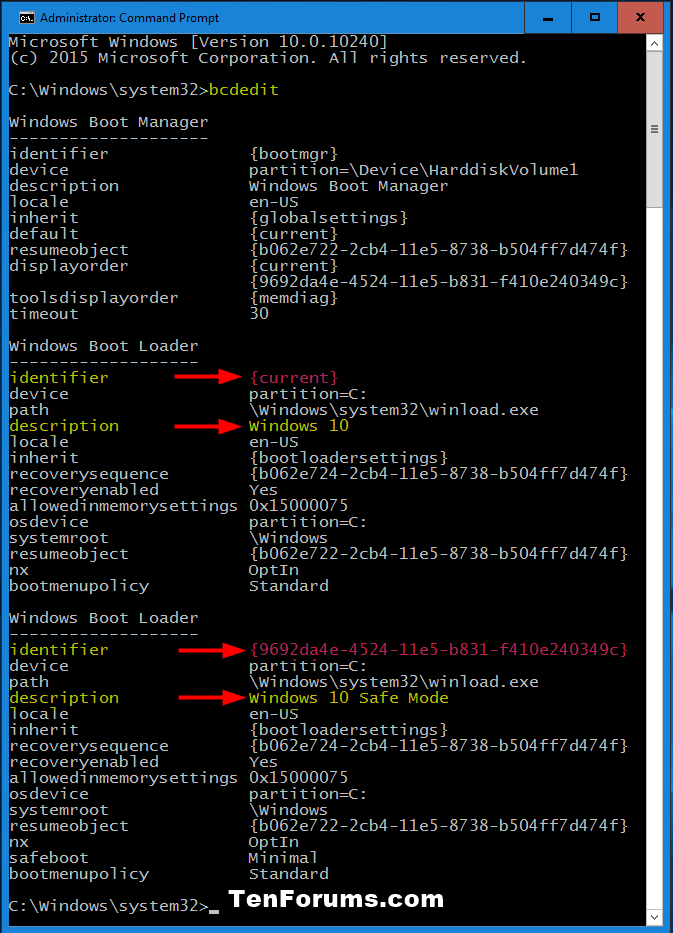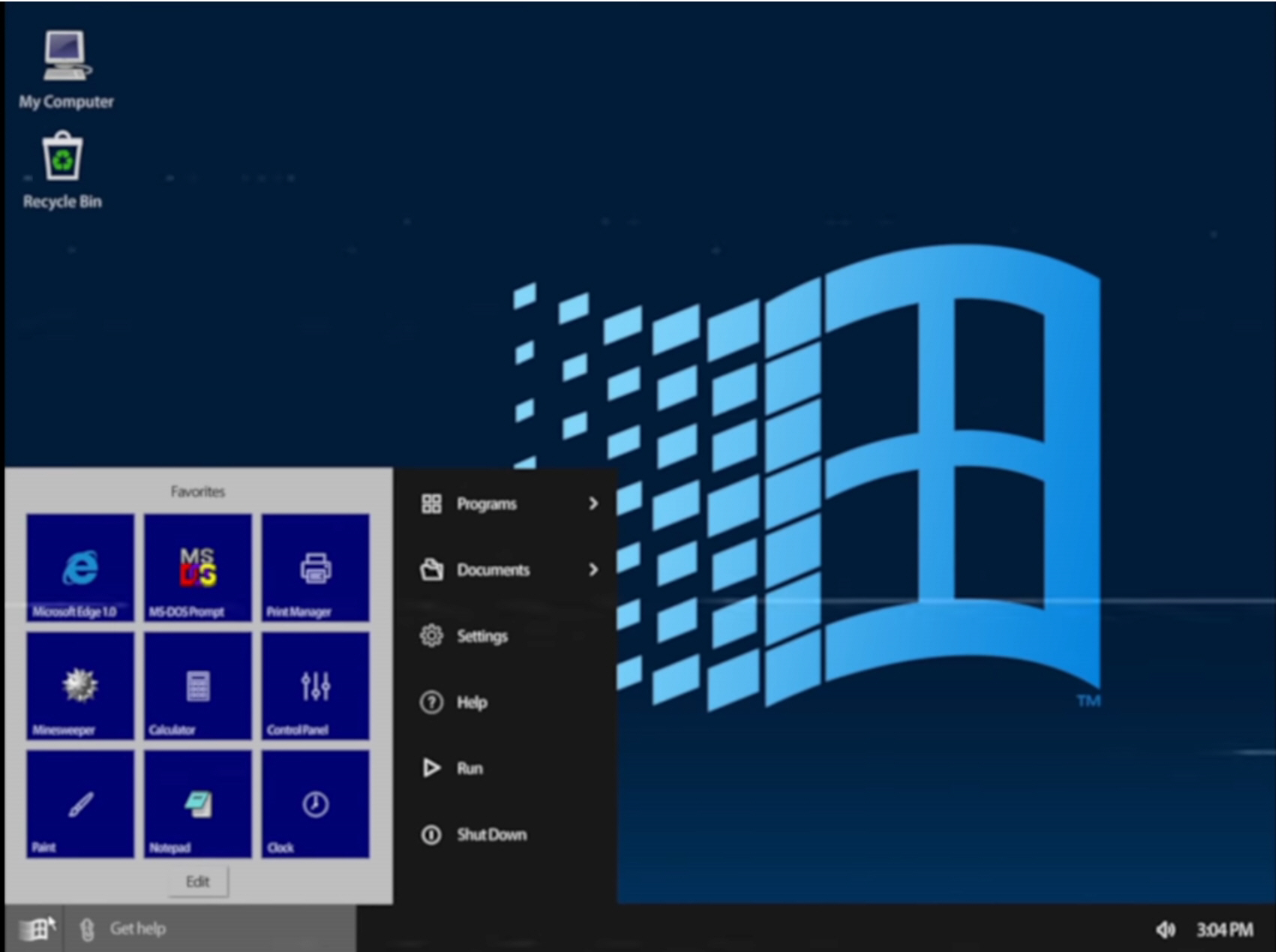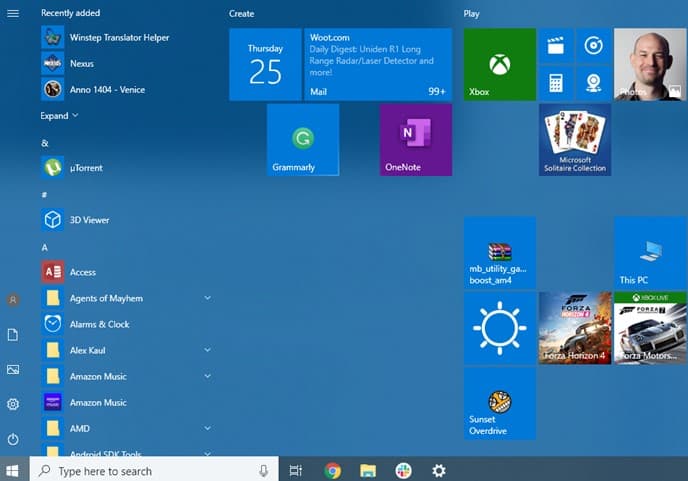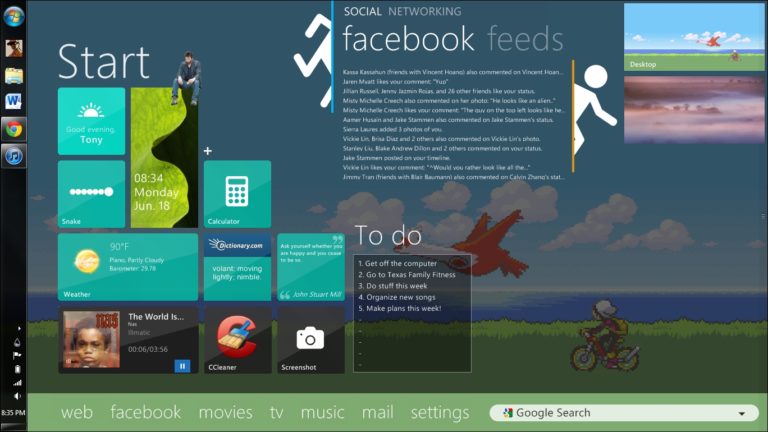As of the May 2019 update, the minimum disk space requirement has been increased to 32 GB. In addition, on new installations, Windows permanently reserves up to 7 GB of disk space in order to ensure proper installation of future feature updates. Other critics argued that Microsoft should not have triggered any downloading of Windows 10 installation files without user consent. The upgrade offer was marketed and initiated using the "Get Windows 10" application, which was first downloaded and installed via Windows Update in March 2015.
Third-party programs were also created to assist users in applying measures to disable GWX. A new iteration of the Start menu is used on the Windows 10 desktop, with a list of places and other options on the left side, and tiles representing applications on the right. The menu can be resized, and expanded into a full-screen display, which is the default option in Tablet mode. A new virtual desktop system was added by a feature known as Task View, which displays all open windows and allows users to switch between them, or switch between multiple workspaces. Universal apps, which previously could be used only in full screen mode, can now be used in self-contained windows similarly to other programs. Program windows can now be snapped to quadrants of the screen by dragging them to the corner.
When a window is snapped to one side of the screen, Task View appears and the user is prompted to choose a second window to fill the unused side of the screen (called "Snap Assist"). Microsoft sells Windows operating systems licenses to PC manufacturers to load on tablets, laptops and desktops, so you can get a Windows machine in any shape, size and price range. The OS boasts compatibility with a wide array of hardware due to extensive driver support, which is significant if you want to work with high-powered software for computer-aided design or video editing. As an operating system for the average home user, Windows 10 Home 32-bit has plug-and-use support for third-party add-ons, so you can add a mouse, keyboard, storage drive, microphone or monitor and start working right away.
What Size Is Windows 11 Operating System When you update a driver, Windows stores details of the previous driver so you can quickly revert to it if the updated driver is not satisfactory. Pro is a desktop edition for PCs, tablets and 2-in-1s. Building upon both the familiar and innovative features of Windows 10 Home, it has many extra features to meet the diverse needs of small businesses. Windows 10 Pro helps to effectively and efficiently manage their devices and apps, protect their sensitive business data, support remote and mobile productivity scenarios and take advantage of cloud technologies. Windows 10 Pro devices are a great choice for organisations supporting Choose Your Own Device programs and prosumer customers.
Extended support until January 13, 2032The original release of Windows 10 receives mainstream support for five years after its original release, followed by five years of extended support, but this is subject to conditions. Microsoft stated that these devices would no longer receive feature updates, but would still receive security updates through January 2023. Microsoft will continue to support at least one standard Windows 10 release until October 14, 2025. 10 product keys, meaning they could be entered during installation to activate the free license, without the need to upgrade first to "activate" the hardware with Microsoft's activation servers.
The OS restricts software installation to applications obtained from Microsoft Store; the device may be upgraded to Windows 10 Pro for a fee to enable unrestricted software installation. As a time-limited promotion, Microsoft stated that this upgrade would be free on the Surface Laptop until March 31, 2018. Windows 10 S also contains a faster initial setup and login process, and allows devices to be provisioned using a USB drive with the Windows Intune for Education platform.
A fresh install of Windows 10 takes up about 15 GB of storage space. Most of that is made up of system and reserved files while 1 GB is taken up by default apps and games that come with Windows 10. This might not sound a lot, but if you have a cheap 32GB Windows laptop or even a 64GB one, it's a significant portion of your storage space taken up by the operating system. For example, the Lenovo Ideapad 100S comes with just 32GB of internal memory and only 17GB of free space out of the box. You can reduce Windows's footprint by uninstalling default Windows 10 apps, disabling the hibernation, and tweaking the virtual memory settings. All of these strategies work in previous versions of Windows, except for uninstalling Windows 10 default apps.
Microsoft says that 16GB is the minimum space needed for the 32-bit version, but 20GB is required for the 64-bit version. I decided on a 50GB virtual drive on my desktop, but feel free to make it as large as you need. Just be sure that you have enough space on your actual hard drive to handle the size of your virtual drive. Depending on what you intend to do with the OS, you may want to allocate more or less storage.
Applications installed to a VM should be assumed to require the same amount of "real" storage that their standard installations would. Windows operating systems andsoftware servicescome with innovations and security updates that allow organizations to stay up-to-date against threats to their investments. Windows Hello and Microsoft Passport in Windows 10 help businesses get rid of passwords and use biometrics and hardware-based techniques for authenticating employees. Credential Guard protects corporate identities in a hardware-based secure execution environment, while Device Guard protects your device against malware from questionable apps. Windows Defender Advanced Threat Protection works alongside antivirus internet security software to protect your computer from malware threats and malicious online links. The ability to multitask with Windows OS saves you time and increases productivity when there are computer tasks you need to complete simultaneously.
If you deal with many open programs, take advantage of the virtual desktop feature in Windows 10 that unclutters the taskbar and organizes programs across multiple desktops. If you have a Plus Drive installed on your device, installing Windows 10 is pretty convenient. However, I don't have any experience with the setup because I'm using a standard corporate computer, which our internal IT staff prefers. So I am not involved in the process of installing Windows 10 from scratch. I get a ready-to-use laptop with some personalizations.
I have to log in and use the correct password to make all corporate resources available on my device. However, in my personal life, I have seen progress with installation from version 7 to version 10. Maintenance on Windows 10 is done by a separate technical team that reacts to tickets and requests for support. They also make recommendations to fix something that is not working correctly.
Sometimes they'll help when there are issues with corporate rules, like security, privileges, and accessing Active Directory. Also, when there was a migration happening in the background, like migration from Office 2016 to Office 365, there were some problems with migrating smoothly. We had to wait until our IT team fixed some features that were not accessible. In March 2016, some users also alleged that their Windows 7 and 8.1 devices had automatically begun upgrading to Windows 10 without their consent.
In June 2016, the GWX dialog's behavior changed to make closing the window imply a consent to a scheduled upgrade. It was concluded that these users may have unknowingly clicked the "Accept" prompt without full knowledge that this would begin the upgrade. Starting with Windows 10 version 2004, Microsoft will require new OEM devices to use 64-bit processors, and will therefore cease the distribution of x86 (32-bit) variants of Windows 10 via OEM channels. The 32-bit variants of Windows 10 will remain available via non-OEM channels, and Microsoft will continue to " feature and security updates on these devices". This would later be followed by Windows 11 dropping 32-bit hardware support altogether, and thus making Windows 10 the final version of Windows to have a 32-bit version.
Feature updates prior to version 1909 are distributed solely as an in-place upgrade installation, requiring the download of a complete operating system package (approximately 3.5 GB in size for 64-bit systems). Unlike previous builds, version 1909 is designed primarily as an update rollup version of 1903, focusing primarily on minor feature additions and enhancements. For upgrades to 1909 from 1903, a new delivery method is used where its changes were delivered as part of the monthly cumulative update, but are left in a dormant state until the 1909 update "enablement" patch is installed. The full upgrade process is still used for those using builds prior to 1903. The Anniversary Update added Windows Subsystem for Linux , which allows the installation of a user space environment from a supported Linux distribution that runs natively on Windows. The subsystem translates Linux system calls to those of the Windows NT kernel .
The environment can execute the Bash shell and 64-bit command-line programs (WSL 2 also supports 32-bit Linux programs and graphics, assuming supporting software installed, and GPUs support for other uses). Windows applications cannot be executed from the Linux environment, and vice versa. Linux distributions for Windows Subsystem for Linux are obtained through Microsoft Store.
The feature initially supported an Ubuntu-based environment; Microsoft announced in May 2017 that it would add Fedora and OpenSUSE environment options as well. Windows 10 received generally positive reviews upon its original release. Anyone adopting Windows 10 can upgrade legacy machines directly from Windows 7 or Windows 8 to Windows 10 without re-imaging or performing intrusive and time-consuming system wipes and upgrade procedures.
To upgrade from a previous version of Windows 10, IT or users run the Windows 10 OS installer, which transfers any applications and software on the previous OS, as well as settings and preferences over to Windows 10. Organizations and users can pick and choose how they will patch and update Windows 10. IT or users can access a Windows 10 upgrade through the Windows Update Assistant to manually begin an upgrade or wait for Windows Update to offer an upgrade when it is set to run. For a long time, many OEMs preinstalled 32-bit Windows on 64-bit capable systems for sound reasons. Many applications and hardware drivers remained compatible with the previous architecture for years.
With the release of Windows 7 in 2009, 64-bit computing finally came into vogue. Software drivers for popular peripherals such as printers and other devices supported the newer architecture. After 10 years of 64 bit in mainstream computing, there are decisions to make when considering an upgrade to Windows 10. The Go Back feature, which allows you to reinstall a previous version of Windows, is available for 10 days after upgrading to Windows 10 . The Windows installation files occupy a large amount of hard drive storage space during that time. However, you can delete them manually if you want to free up storage space before then.
This edition is designed for "special-purpose devices" that perform a fixed function . For this reason, it excludes Cortana, Microsoft Store, and all bundled Universal Windows Platform apps . As with so many installation tutorials, the speed of this process will depend on the hardware you're working with. An SSD will be much faster than a mechanical hard drive for reinstalling Windows 10. Considering you'll be downloading new software, it will also take a long time if you're internet connection is slow.
Read our tips on how to speed up your internet if you think this might be an issue. The user interface is somehow good for me because it's based on web design and all this user-friendly stuff. It allows for faster selection of applications and it streamlines research functions, like obtaining that information file or something like this. One useful feature of Windows 10 is its connectivity with mobile devices and ability to make cableless connections with external devices. Windows 10 has made some improvements in performance, so it's not consuming hardware resources like Windows 7.
Now, on the other hand, 7 GB of storage space is specifically reserved for downloading and installing updates. Although 7 GB disk space shouldn't be causing much trouble for a contemporary machine, each gigabyte of storage holds importance when it comes to older PCs or even some mobile devices, whose storage cannot be upgraded either. 10 Home and Pro is "Semi-Annual Channel " (formerly "Current Branch", or "CB"), which receives stable builds after they are publicly released by Microsoft. Each build of Windows 10 is supported for 18 months after its original release.
The new Start menu takes after Windows 7's design by using only a portion of the screen and including a Windows 7-style application listing in the first column. Myerson said that these changes would occur in a future update, but did not elaborate. Windows Phone 8.1 would share nearly 90% of the common Windows Runtime APIs with Windows 8.1 on PCs. Laptops that come with SSD usually have just 128GB or 256GB of storage, which is enough for all your programs and a decent amount of data.
However, users who have lots of demanding games or huge media collections will want to store some files in the cloud or add an external hard drive. In a game of size-does-matter, Windows running in S Mode has an installed size of about 5GB on the hard drive. A Windows 10 full-installation can range from about 20GB to 40GB, depending on the edition and features chosen.
For the AMD 64 processor, the company noted 32-bit versions of Windows gaining a 9% performance boost from running on 64-bit hardware. The same could be true even for modern 32-bit versions of Windows 10. Microsoft first released a 64-bit version of Windows in 2005. The 64-bit processor, which AMD first brought to market in 2003, unleashed many potentials, such as improved security and performance for games and industrial applications and the ability to address more memory. If you wish to run both macOS and Windows on a single Mac computer, UITS recommends using Apple's Boot Camp utility to install Windows 10 on your Intel-based Mac. In macOS, the Boot Camp Assistant app will help you partition your Mac hard drive to accommodate both operating systems, so you can install Windows from an installation disk or an ISO image stored on a USB flash drive.
First make sure you have a full backup of your data since will be installing on top of the existing data. You can download the Windows 10 media from the Windows 10 .iso download site and then set the computer to boot from the flash drive. Typically, I find this is often the hardest part of the process — finding the combination of keys that allows you into the bios to force the system to boot from the flash drive. Windows 10 OEM is a full version of the operating system not an upgrade. The OEM operating system is not supported by Microsoft. To acquire Windows software with support provided by Microsoft please see our full package "Retail" product.
Microsoft recommends all files and programs be backed-up prior to installation. Microsoft's licensing strategy is constantly changing. In a few years, we might only be using cloud versions for the Microsoft operating system.
For example, I know the average price of a standard operating system for home use, but I see the enterprise version much more expensive than the version for home users. I'm usually buying products for private use based on my company's different price preferences. I'm always buying this combined version that includes the hardware and software. One of the most valuable features is the ease of multitasking. It's easy to switch over different applications and multitasking is very free and flawless.
Another useful feature is the ability to recover any data from a crash. Multiple benchmarking applications are supported by Windows, which isn't the case with Linux. So in case you need an application, you can Google it, find it, and easily install it. If you have the SSD installed in the laptop or machine, it will start like a boom.
There is a way to install Windows 11 on unsupported hardware, but we wouldn't recommend it. Although Microsoft hasn't confirmed it, the company has heavily implied that unsupported users won't receive critical security updates. If you still want to install, you can do so using the Media Creation Tool, which bypasses hardware checks. Windows will do some more calculations and give you another a remarkably similar looking box, this time with the option to delete previous windows installation. You might have to scroll down to find it, but it should be taking up a sizeable bit of drive space, in our case, 5GB.
In the separate message box that appears asking if you're certain you want to send this, click Delete Files, and you're done. The HP Recovery Manager program is part of the original hard drive image on HP computers released before 2018. It can be used to recover the operating system from files stored in a partition on the hard drive without needing recovery media. It can also be used to create a personalized recovery disc or USB drive for a specific computer. Microsoft continues to test new features and improvements after Windows 11 was released. It only tests the latest version of Windows with members who participate in the Windows Insider Program in the Dev, Beta and Release Preview channels.

























No comments:
Post a Comment
Note: Only a member of this blog may post a comment.